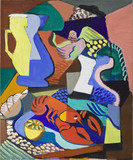Jan Matulka was active in the New York avant-garde during the decades between the world wars. His greatest impact was as one of the few modernist teachers in New York during the late 1920s and early 1930s. Matulka studied art in Prague for two years before his family immigrated to New York in 1907. In 1908 he began studying at the National Academy of Design, where he won the Joseph Pulitzer Prize, which enabled him to travel during 1917 and 1919 through Florida, Mexico, the Southwest, and Canada. Around 1916, as a result of his friendship with James Daugherty (1887-1974) and Jan Van Everen (1875-1947), he began to explore less-conservative ideas, and by 1920 he exhibited abstract works at the Société Anonyme’s gallery in New York and in its landmark International Exhibition of Modern Art held at the Brooklyn Museum of Art in 1926. From 1920 to 1925 he made several extended trips to Europe, spending most of his time working in Paris and summering in Czechoslovakia. He became deeply involved in the artistic and intellectual life of Paris and Prague and exhibited with other European modernists in both cities. In New York Matulka participated in many group exhibitions, often at the Whitney Studio Club, and began his first sustained commercial affiliation with his 1927 exhibition at the Frank K. M. Rehn Galleries in New York. He became an active printmaker at this time. After 1925 his increased political consciousness was reflected in numerous illustrations contributed to the communist publication New Masses and his serving as artistic advisor to the Marxist Czech-American Delnìk Kalendar (Worker’s Almanac). From 1929 to 1932 Matulka was an instructor at the Art Students League. With his extensive knowledge of advanced art trends of Western and Eastern Europe, he was one of the few teachers in New York who could encourage his students-among then Burgoyne Diller (19061965), Irene Rice Pereira (1907-1971), and David Smith (1906-1965)-to adopt modernism. During the Great Depression Matulka worked on various New Deal projects and was one of the few abstractionists to design murals, one of which was placed in the Williamsburg Federal Housing Project in Brooklyn.
Matulka’s first modernist works were landscapes and still lifes influenced by the early work of Pablo Picasso (18811973), but by the 1920s he fell under the spell of the purists, such as Fernand Léger (1881-1955), and produced his most abstract still lifes and cityscapes. His later still-life compositions were similar to the work of Stuart Davis, while his landscapes reflected the influence of both Paul Cézanne (1839-1906) and the expressionists. By the mid1940s Matulka was no longer considered an important figure in the art world. His work thereafter decreased in quality.
BIBLIOGRAPHY
Archiv. Am. Art, Jan Matulka Papers § Wilmington, Delaware Art Museum, Avant-garde Painting and Sculpture in America, 1910-25, exh. cat., 1975, p. 98, "Jan Matulka," by Gilbert T. Vincent, with bibliography § Washington, D.C., Smithsonian Institution, National Collection of Fine Arts, and others, Jan Matulka, 1890-1972, exh. cat., 1980, published by Smithsonian Institution Press, with essays by Patterson Sims, Merry A. Foresta, and Dorothy Dehner, chronology, checklist of known prints by Janet A. Flint, lists of exhibitions, works in public collections, bibliography.

